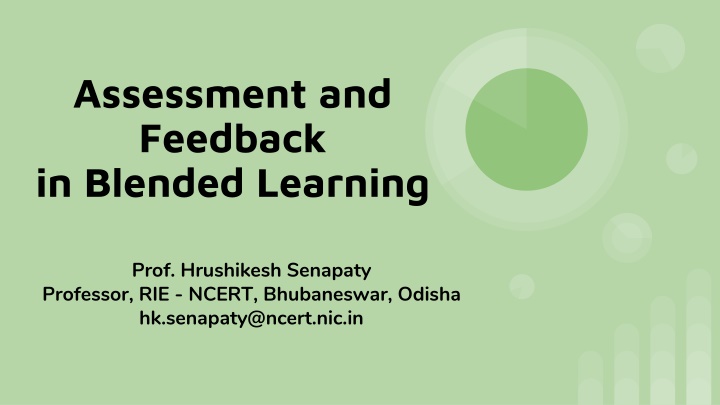
Enhancing Learning with Innovative Assessment Practices
Explore the concepts of assessment in blended learning, aligning assessment with learning objectives, holistic assessment methods, and innovative trends in assessment. Understand how to assess learners' readiness for blended learning and engage them through diverse activities to foster meaningful learning.
Download Presentation

Please find below an Image/Link to download the presentation.
The content on the website is provided AS IS for your information and personal use only. It may not be sold, licensed, or shared on other websites without obtaining consent from the author. If you encounter any issues during the download, it is possible that the publisher has removed the file from their server.
You are allowed to download the files provided on this website for personal or commercial use, subject to the condition that they are used lawfully. All files are the property of their respective owners.
The content on the website is provided AS IS for your information and personal use only. It may not be sold, licensed, or shared on other websites without obtaining consent from the author.
E N D
Presentation Transcript
Assessment and Feedback in Blended Learning Prof. Hrushikesh Senapaty Professor, RIE - NCERT, Bhubaneswar, Odisha hk.senapaty@ncert.nic.in
Concept of Assessment Traditional concept of assessment Assessment is separate from Teaching learning Deficit model of assessment Modern concept of Assessment Assessment is an integral part of teaching learning Strength model of assessment
Holistic Assessment Modes of Assessment Assessment of learning Assessment for Learning Assessment as learning Assessment from the perspective of NEP 2020 Student involvement in Assessment Self Assessment Peer assessment Assessment by the teacher
Assessment in Blended Learning Assessment of learners need and preparedness for blended learning There is need of gathering information about learners background Learners access to technology How will they use these technology? What is their skill level ?
Aligning Assessment with Learning Objectives Intended learning outcomes Assessment criteria Teaching learning activities Both summative and formative assessment can be used In formative assessment, learning is reviewed and supported Learning continues to produce product that demonstrate knowledge and skills This helps in diagnosis of misunderstanding and provide feedback and guidance for continued progress
Assessing learning through activities involving application, problem solving, and creativity fosters meaningful learning Assessment activities may include group projects, peer assessment, theory and model building and structured academic debate.
Innovative Trends in Assessment Formative Assessment E-portfolio Rubrics Creative products Online quizzes Use of AI tool for assessment Summative assessment Open Book examination Group examination Spoken examination On demand examination
Types of Assessment in Blended learning Online Assessment Product and process assessment Continuous and comprehensive assessment Open book/close book assessment Group Assessment Viva voce Project Assessment e-portfolio
Feedback in Blended Learning Self-feedback Peer group feedback Feedback on Teaching learning process Feedback on Learning resources Feedback on Learning activities Feedback on Learning outcome
Conclusion Holistic Assessment is the need of hour. To implement it in our educational institutions there is need of using both the testing and non testing techniques. Test is the most authentic tool for objective assessment. Rubric is the most authentic tool for subjective assessment. There is an urgent need of using both the testing and non-testing techniques in blended learning so that we can assess the learner from a holistic perspective. It will not only help to assess, what they are learning, but also, how they are learning.
